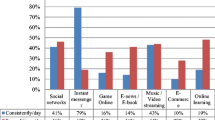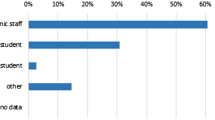Abstract
The rapid adoption rate and integration of mobile technology (tablet computing devices and smartphones) by physicians is reshaping the current clinical landscape. These devices have sparked an evolution in a variety of arenas, including educational media dissemination, remote patient data access and point of care applications. Quantifying usage patterns of clinical applications of mobile technology is of interest to understand how these technologies are shaping current clinical care. A digital survey examining mobile tablet and associated application usage was administered via email to all ACGME training programs. Data regarding respondent specialty, level of training, and habits of tablet usage were collected and analyzed. 40 % of respondents used a tablet, of which the iPad was the most popular. Nearly half of the tablet owners reported using the tablet in clinical settings; the most commonly used application types were point of care and electronic medical record access. Increased level of training was associated with decreased support for mobile computing improving physician capabilities and patient interactions. There was strong and consistent desire for institutional support of mobile computing and integration of mobile computing technology into medical education. While many physicians are currently purchasing mobile devices, often without institutional support, successful integration of these devices into the clinical setting is still developing. Potential reasons behind the low adoption rate may include interference of technology in doctor-patient interactions or the lack of appropriate applications available for download. However, the results convincingly demonstrate that physicians recognize a potential utility in mobile computing, indicated by their desire for institutional support and integration of mobile technology into medical education. It is likely that the use of tablet computers in clinical practice will expand in the future. Thus, we believe medical institutions, providers, educators, and developers should collaborate in ways that enhance the efficacy, reliability, and safety of integrating these devices into daily medical practice.



Similar content being viewed by others
References
Peck, A. D., App-solutely fabulous. Hundreds of new apps for iPAD and tablets make mHealth a reality and a lifestyle choice. Med. Econ. 88(22):S11–S14, 2011.
Collins, F., How to fulfill the true promise of “mHealth”: Mobile devices have the potential to become powerful medical tools. Sci. Am. 307(1):16, 2012.
Martin, S., MD’s computer, PDA use on the upswing. CMAJ 167(7):794, 2002.
Carney, P. A., Poor, D. A., Schifferdecker, K. E., Gephart, D. S., Brooks, W. B., and Nierenberg, D. W., Computer use among community-based primary care physician preceptors. Acad. Med. 79(6):580–590, 2004.
Garritty, C., and El, E. K., Who’s using PDAs? Estimates of PDA use by health care providers: A systematic review of surveys. J. Med. Internet Res. 8(2):e7, 2006.
Burt, C. W., and Sisk, J. E., Which physicians and practices are using electronic medical records? Health Aff. (Millwood) 24(5):1334–1343, 2005.
DesRoches, C. M., Campbell, E. G., Rao, S. R., et al., Electronic health records in ambulatory care–a national survey of physicians. N. Engl. J. Med. 359(1):50–60, 2008.
Kho, A., Henderson, L. E., Dressler, D. D., and Kripalani, S., Use of handheld computers in medical education. A systematic review. J. Gen. Intern. Med. 21(5):531–537, 2006.
Franko, O. I., and Tirrell, T. F.. Smartphone App use among medical providers in ACGME training programs. J. Med. Syst. 2011.
Hormby, T., The story behind Apple’s Newton. 2006; http://lowendmac.com/orchard/06/john-sculley-newton-origin.html. Accessed May 7, 2012.
Apple. Apple Launches iPad. 2010; http://www.apple.com/pr/library/2010/01/27Apple-Launches-iPad.html. Accessed July 9, 2012.
Bright P. Ballmer (and Microsoft) still doesn’t get the iPad. 2010; http://arstechnica.com/information-technology/2010/07/ballmer-and-microsoft-still-doesnt-get-the-ipad/. Accessed May 7, 2012.
IDC. Media tablet and ereader markets beat second quarter targets, forecast increased for 2011, according to IDC [Press Release]. 2011; http://www.idc.com/getdoc.jsp?containerId=prUS23034011. Accessed July 9, 2012.
Research G. Gartner says worldwide media tablets sales to reach 119 million units in 2012. 2012; http://www.gartner.com/it/page.jsp?id=1980115. Accessed July 9, 2012.
Katz, M. H., Mobile tablets: Benefits to residents and patients. Arch. Intern. Med. 172(5):438, 2012.
Technology, B. L., Will iPads lead to a technology arms race? Hosp. Health Netw. 84(3):20, 2010.
Cooper, L., Tablets in clinical settings: are they up to the job? Compliance and durability concerns may be holding consumer-grade tablet computers back. Interview by Gabriel Perna. Healthc. Inform. 29(4):39–40, 2012.
Patel, B. K., Chapman, C. G., Luo, N., Woodruff, J. N., and Arora, V. M., Impact of mobile tablet computers on internal medicine resident efficiency. Arch. Intern. Med. 172(5):436–438, 2012.
Hegarty, C., Barringer, K., Nelson, J., Binstadt, E., and Raghunandan, S., 2012 Innovations in Emergency Medicine Education (IEMEs). Acad. Emerg. Med. 19:S394–S411, 2012.
Vawdrey, D. K., Wilcox, L. G., Collins, S. A., et al., A tablet computer application for patients to participate in their hospital care. AMIA Annu. Symp. Proc. 2011:1428–1435, 2011.
Escobar, S. K., Escobar, E. D., Whitten, C., and Griffen, J. D., Texas iPad anesthesia education domain. American Society of Anesthesiologists Annual Meeting, Chicago, 2011.
Strayer, S. M., Semler, M. W., Kington, M. L., and Tanabe, K. O., Patient attitudes toward physician use of tablet computers in the exam room. Fam. Med. 42(9):643–647, 2010.
Mc Laughlin, P., Neill, S. O., Fanning, N., et al., Emergency CT brain: Preliminary interpretation with a tablet device: Image quality and diagnostic performance of the Apple iPad. Emerg. Radiol. 19(2):127–133, 2012.
Soehngen, E., Rahmah, N. N., Kakizawa, Y., et al., Operation-microscope-mounted touch display tablet computer for intraoperative imaging visualization. World Neurosurg. 77(2):381–383, 2012.
Agresti, A., and Coull, B. A., Approximate is better than “exact” for interval estimation of binomial proportions. Am. Stat. 52(2):119–126, 1998.
Morris, M. G., and Venkatesh, V., Age differences in technology adoption decisions: Implications for a changing work force. Pers. Psychol. 53(2):375–403, 2000.
Disclosures
The authors declare that they have no conflict of interest.
Funding
None
Author information
Authors and Affiliations
Corresponding author
Electronic supplementary material
Below is the link to the electronic supplementary material.
ESM 1
(DOCX 4478 kb)
Rights and permissions
About this article
Cite this article
Sclafani, J., Tirrell, T.F. & Franko, O.I. Mobile Tablet Use among Academic Physicians and Trainees. J Med Syst 37, 9903 (2013). https://doi.org/10.1007/s10916-012-9903-6
Received:
Accepted:
Published:
DOI: https://doi.org/10.1007/s10916-012-9903-6




